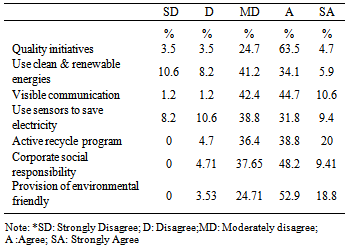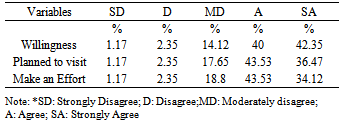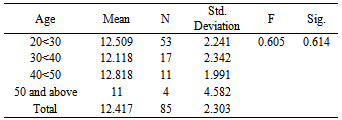-
Paper Information
- Next Paper
- Paper Submission
-
Journal Information
- About This Journal
- Editorial Board
- Current Issue
- Archive
- Author Guidelines
- Contact Us
Management
p-ISSN: 2162-9374 e-ISSN: 2162-8416
2013; 3(7): 427-433
doi:10.5923/j.mm.20130307.13
Exploring Visitors’ Attitude towards Green Practices and Revisit Intentions of a Tourist Destination
Raemah Abdullah Hashim1, Zulaika Zakariah1, Wardah Mohamad1, Sidi Merican2
1Faculty of Business and Management, Open University Malaysia
2UNiKL Business School, University Kuala Lumpur
Correspondence to: Raemah Abdullah Hashim, Faculty of Business and Management, Open University Malaysia.
| Email: |  |
Copyright © 2012 Scientific & Academic Publishing. All Rights Reserved.
The study seeks to explore the relationship between attitude towards green practices and the revisit intentions among visitors in a tourist destination in Malaysia. It has been argued that revisit intentions may result in financial sustainability and profitability to the industry. Total useable questionnaires were 85 with a response rate of 27 percent. The result revealed that there is a no significant relationship between attitude towards green practices and the revisit intentions. However, descriptive statistics reveal that high percentage of visitors are in agreement that green initiatives is important and also it should be visibility communicated to the society at large. This study implies to the policy makers they should focus green destination in Malaysia. Future study should consider alternative modes of enquires such as employing the longitudinal method of data collection design and a nationwide survey covering samples from other tourist destinations in Malaysia that would be more significant in making generalizations.
Keywords: Green practices, Malaysia, Attitudes, Revisit intentions
Cite this paper: Raemah Abdullah Hashim, Zulaika Zakariah, Wardah Mohamad, Sidi Merican, Exploring Visitors’ Attitude towards Green Practices and Revisit Intentions of a Tourist Destination, Management, Vol. 3 No. 7, 2013, pp. 427-433. doi: 10.5923/j.mm.20130307.13.
Article Outline
1. Introduction
- By the year 2020, the tourism industry in Malaysia is expected to contribute about RM6.5 billion in Gross National Income and job creation of 37,900 as reported in the National Key Economic Areas (NKEA) report of 2011. In achieving this aspiration, one of its strategies will be to focus on high yield niche market in the eco-tourism (nature and adventure) sector. The government had in the past allocated a substantial amount of money in not only promoting Malaysia as an eco friendly destination and also have given incentives and tax exemption for some sector of the industry that embark on eco friendly practices[26]. Eco friendly practices are synonymous to green travel and normally appeals to travelers that are concerned with environmentalsustainability[13]. Others define it as environmentally and socially responsible[17]. However, Green[9] reported that consumers tend to respond differently towards green companies based on their level of environmental awareness.Consequently, it was reported that investment in green practices can be triple over the regular ones. The glum environmental issues related to the tourist industry such as found in the lodging would be wastage in the usage of energy, water, air quality and waste management have been in the minds of consumers that presumably will affect the global wellness for the future generation[29],[19]&[22]. Jackson [14] contended that negative impact had lead to consumer and the business support on the drive towards green practices that will be most benefiting in terms of cost saving besides painting a good corporate image. Community’s support on the drive towards green practices that will be most benefiting in terms of cost saving besides painting a good corporate image. Though there are growing numbers of destination operators who had adopted green practices but the question is, whether their visitors are willing to revisit green destination is questionable[4]. Bigne et. al[4] found visitors’ short or long term revisit intensions were determined by differentiated variables. Image and satisfaction were found to be unrelated to revisit intensions in the short run, whereas reverse the in the long run. A recent study in Malaysia by Rahbar and Wahid[27] in the retail industry conjured that Malaysian public and private sectors were in agreement and optimistic about safeguarding the environment but were unable to make a clear demarcation between green or non green products. Probably educating the masses in this area are necessary as the society at large still thinks it as novelty. Nevertheless, another study by Jayaraman, Lin, Guat and Ong[16] revealed that Singaporean revisit intentions into Malaysia is due to other reasons such as visiting friends and relatives, to be entertained, to shop, eat and the ease of visa restriction. Conversely, past study in other parts of the world has indicated that consumer would revisit chosen green lodging over a standard one[22], but they were not willing to pay for such practices nor completely support green program[27]. However, there were limited studies especially in Malaysian context to identify consumer attitude towards eco-friendly tourist destination and their intentions to revisit. The tourist industry in Malaysia thus has a role to play especially in providing not only high quality tourism product and services but also embarking on green practices in order to be sustainable. Therefore, to address the gap, this study main purpose is to elucidate information on visitors’ attitude and their revisit intensions in a tourist destination. This paper would also explore important aspects of the variables under study and also in relation to chosen demographic elements. Based on the findings of this research, it is hope that it would also provide some information and understanding that will assist the leaders and policy makers in Malaysian on global green management issues that will have an impact on the environment sustainability in preserving ecotourism products and preserving our nature and heritage for future generation. This paper consists of five sections. The first section briefly introduce of the study. It is followed by a review of current and past literatures on visitors’ revisit intensions and tourist attitudes towards green practices. The third section, explains the methodology and research design. The fourth section, the study presents the discussions on the findings. In the fifth section, discussion of the conclusion and implication of the study.
2. Literature Review
2.1. Visitors’ Revisit Intention
- Azjen and Fishbein[1][2] found that most individuals are predictable based on her/his intentions and is considered to be an important factor in explaining the individual’s strong intention to perform a certain behavior. Therefore, in developing consumer awareness of a green product, companies attempt to augment consumer knowledge of the product and its environmental attributes in the hope of bringing about purchase behavior[28]. People are increasingly concerned about their surrounding environment in particular to how their tourism consumption affects a destination. Besides being concerned about global warming, travelers are more likely to select a hotel or restaurant which is green and eco-friendly[10][20]. Green practices are a global trend and when green management was first introduced, the first reasons for hotel to ‘go green’ centered on complying with government regulations and saving money by reducing waste and energy usage[10]. Past studies on green practices were directly associated with the environment[21][18][5], green practices as enhancing corporate image[3][9], customer satisfaction and demand[7], willingness to pay a premium for green products[10][19]. The result of some study also shown that there were a growing number of customers demanding green hotels[21][30]. Past study in the lodging industry, by Han et.al[12] found that eco-friendly attitude affects hotels guests’ intentions to visit a green hotel through the spread of positive word of mouth and willingness to pay more. DoValle et.al[7] stated that tourist satisfaction is one contributing factor to destination loyalty intention and loyal intention could be attained from highly satisfied tourists and the improvement of the destination competitiveness. Lien et.al[20] professed that green consumption behavior intentions include using friendlier environmental products, reduce unnecessary consumption and conserve resources, use of recyclable , low pollution, resource saving, reusable products, resource recovery and recycling system for use. Kim and Han[19] found that the consumer attitude towards paying for green hotel were based on their level of awareness on the environmental conditions and how ‘green’ the hotel markets itself. Tzschentske et.al.[31] argued that the environmental credentials on service accommodation lured tourists to a green hotel and Chan[5] strengthened the argument by stating that hotel operators need to adopt the ISO4001 as a ‘standard’ green hotel procedure to assess the energy consumption. In addition some scholars proposed that government policy and support in encouraging responsible environmental behavior would attract international tourists particularly appealing to the overseas market[22][29]. Past study in Malaysia conducted in Klang Valley by Kasimu et.al.[18] found that the wide concentration in energy management not only enhances the hotel’s image but concurrently attracted substantial tourists locally and internationally. Rashid[28] affirmed that to inculcate consumer awareness on green products television and newspaper/magazines would play an important mediating medium. However, to date very few studies was done on visitor’s intention to revisit a green destination especially in Malaysia context.
2.2. Visitor’s Attitudes
- In conceptualizing attitude towards behavior intention to revisit, spreading good words of mouth, Hans and Lee[10] found that hotel guests have an optimistic attitude towards green practices. The importance of attitude towards green practices is also identified in the previous literature[22][19]. In order to create green conscious among potential visitors, marketers of green destination should get consumer support through promoting the positive image of green practices. Consumer attitude towards green initiatives thus can be defined as a predisposition of consumers to respond in a favorable or unfavorable manner towards green efforts by suppliers. A study by Zhuping and Qiang[32] on the consumer's intensity of understanding green hotel and green consumption found that China lodging consumer might want to cooperate in saving the green efforts of the lodging owner but were skeptical when it comes to imposing a higher rate than a standard hotel of the same kind. It was also clearer than the consumers were willing to cooperate in some green initiatives such as electricity and water saving, but was unwilling to accept the idea of unchanged of bed linens or using washing sack nor wanted to support the idea of using recycled articles. It was suggested further support from the state and trade organization is needed to propagate a green consciousness among consumers. Unlike the Green Tourism Association (GTA) of Toronto who had successfully raise tourist green consciousness which contributed successfully to the development of urban sustainable travel, or “urban green tourism”[8].
3. Methodology and Research Design
- A quantitative cross sectional analysis survey research was deployed in this research mainly due to time and resource factors. This study was designed meant for exploratory study and self administered methodology approach to collect data on the respondents on their attitude towards “green destination”. The survey was done at a tourist destination offering a specialty product that in the state of Selangor, Malaysia. The destination opened to the public from 7.30pm to 10.30 pm. This study was also done based on an individual basis and the criteria used is in line with past study carried out by[22]. The respondent selection was based on their first visit to the particular tourist destination of research interest. The data were collected over a period of one month on only weekends at the destination due to constrain in terms of time, resources and personnel[6].Hair, Money, Page & Samouel,[11] espoused that three considerations must be taken into account in ensuring that the instrument captures the desired data from the respondents, they are: the general design of the questionnaire, the validation by pre-testing, and methodologies by which the questionnaires were administered. The instruments for this study were adapted from various studies and were pre tested before the actual survey was carried out. Using a 5-Point Likert-type scale, the respondent indicated their intensity of agreement anchored by 1, “strongly disagree” through to 5, “strongly agree” with items phrased. The instrument used to measure the visitors’ attitude and revisit intentions were an adaptation from Manakota and Jauhari[22] and Bigne, Sanchez & Andreu[4] respectively. For the study 300 questionnaires were distributed. The overall response rate was 27 percent which was slightly better than what was reported generally in the Malaysian context[23].To assess the reliability of the measurement items of all the variables, the researcher utilized the Cronbach’s Alpha coefficient analysis to test the reliability of the instruments. The instrument was tested for internal reliability and the following Table 3.1 demonstrates the scales generated.
|
4. Findings/Discussion
- Tables 4.1, above summarize the demographic profiles of the respondents. The demographic profile characteristics include the gender, age group, qualification, occupation and work experience. The proportion of samples drawn between the genders was approximately 64 percent were female and 36 percent were males. The difference is quite marginal when considering the number of respondents, 31:54 (54 were females and 31were males) and considered appropriate to represent the population. According to Mardia[23], in order to ensure “robustness” in multivariate or other data analysis techniques, even with unequal sampling, and a few dependent variables, a sample size of 20 in the smallest cell would prove to be sufficient.
|
|
|
|
|
|
|
|
|
|
5. Conclusions and Recommendations
- Prior to this study, there were limited writings as a point of reference to attitude towards green practices and intention to revisit a tourist destination in Malaysia. Past studies were done in other industries for example in the retailing industry [27]. This result of this study established that there are great potential in green practices of the Malaysian destination operator. Though it was reported that green initiates can be costly. The majority of the visitors demonstrated a positive attitude towards green practices and indicated their intention to revisit green destination in future. The study also demonstrated that there are not significant differences in attitude or intention to revisit with regards to gender, age and qualification except visitors’ attitude towards green practices based on qualifications. Although there was a significant difference in visitor’s attitude based on respondents’ qualification, the magnitude of the differences in the means as being very small to be differentiated. While there is an indication that most of the visitors are in strongly in agreement that green practices should be communicated, in reality they are not communicated visibility to visitors in the form of signage, corporate responsibility initiates and publicity. From the management perspective, the findings from this study had provided information and further understanding that will assist the leaders and policy makers on the global green management issues that will have a positive impact on the development of multiple eco tourism activities and appreciation of nature and heritage. Tourism destination business can also look into the opportunity to add specialty packages that would focus on authentic adventures while conserving the environment. This will definitely contribute substantially to the expansion of the appeal of their product and service offerings. Though we have come to turn that investment in green practices for future generation can be substantial and considered by investors as a long term investment, therefore information on visitors intention to revisit to green destination in their future travel is fundamental. This is especially true for policy makers and management in developing successful marketing strategies. From the theoretical perspective, the finding from this exploratory study intends to propose a framework in green practice management and marketing discipline. It suggests better clarity over the previous study on consumers’ attitude towards green practices in different context and industry. Future studies should also consider the inclusion of other variables such as customer satisfaction and price to gain better insights into the revisit intention. Future studies should also consider alternative modes of inquiry such as employing the longitudinal method of data collection design (e.g. experiments, archival data, observations or interviews) and since this study is limited to a tourist destination in Malaysia that only offer a single tourism product, a nationwide survey covering samples of all tourist destinations in Malaysia to be considered. There were also limited studies carried out in terms of context and it is believed that the findings from this research will be relevant for future research to be replicated in other service industries such as hospitality, health services and even in education services.
 Abstract
Abstract Reference
Reference Full-Text PDF
Full-Text PDF Full-text HTML
Full-text HTML









